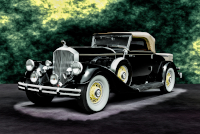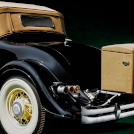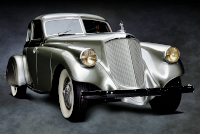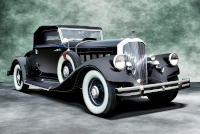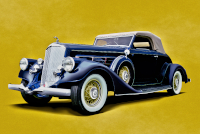Location:
York Concours d'Elegance, 2008
Owner: Dave Humbert | Hanover, Pennsylvania
Prologue:
In 2008 I spent hours pouring over Michael Furman's, "Motorcars of the Classic Era." That book (and the message perpetuated by the 100 Motorcars of Radnor Hunt) is the reason that our 12cylinders index button reads 'Motorcars' in the first place. In any case, way back then at the soon-to-be-defunct York show, we met this Model 1242 Pierce-Arrow, which I recognized as one of the cars in Furman's first publication. This car is not identical, but close enough to spark a certain ambition. I was still quite new to the concours scene at the time, and the thought that I could take a photograph of the same model depicted in Michael Furman's book struck me as rather radical.
Even if my enthusiasm were genuine, my early photographs were not so sparkly, and only a mere 15 years later have I finally edited these old images. In that time I've learned a lot of tricks, so the product is rather far from the subdued static work I aimed for early on. And I'm happy to resurrect old photo stock, particularly because the smaller scale invites creativity and risk. In the case of this main image, I developed two new illustrative techniques. Such is the benefit of tackling a problematic source image, and the value of being able to draw.
Also note that while I post the owner at the time of photography, this Pierce-Arrow passed from Mr. Humbert to a subsequent owner, who then sold the car at RM's Hershey auction in 2015.
- - - - - - - - - -
► Image Source: Nikon D200 (10.2 MP)
References:
- Ralston, Marc. "Pierce-Arrow" A.S. Barnes & Co., Inc., San Diego, CA. 1980, page 178-179, 232
- Automobile Quarterly, Volume 28, Number 4, Fourth Quarter 1990, "The Last Years of Luxury" by John C. Meyer III, The Kutztown Publishing Company, Inc., Kutztown, PA, page 73, 92
- Pierce-Arrow Custom Salon Twelves Sales Brochure, 1933, Buffalo, New York: Vintage source for technical detail and fact-checks.
- RM Sotheby's: See the 2015 auction description, which unfortunately omits the chassis number, but provides owner history.
- Wikipedia: A quick check on Tyler State Park, original home of this Model 1242.
We address the Model 1242 Convertible Coupe Roadster in the profile of the earlier chassis #3100006. Only three survive today of five built in 1933. When new, this particular Model 1242 quickly became woven into Pennsylvania history. The story is one not so readily apparent, yet connects to the present-day landscape in many facets.
The Tyler Family, Temple University, and Bucks County Community College
In typical Pierce-Arrow fashion, George F. Tyler, son of an exceedingly wealthy investment banking family, originally purchased the convertible. He has recently married Stella Elkins Tyler, herself an oil and land development heiress. Together, they acquire farm land in Bucks County, north of Philadelphia, surrounding the Tyler's country home. Here, they build a large country estate from 1930 to 1931. This new Pierce-Arrow arrives in 1933, joining a ten-car stable. In a devotional gesture worthy of any present-day übergarage (but probably derived from railway lexicon), Tyler installs an electric turntable for the Pierce-Arrow, allowing him simple ingress and egress. He keeps the Model 1242 until his death.
While the car passes to other owners, Stella bequeathes the Bucks County estate to Temple University in 1963, who then sell the property to the Commonwealth. Today the land is divided. A 200-acre parcel forms the Bucks County Community College, including the mansion, which still serves as its administrative offices. This campus would be the 1242's original home put to public use. The estate's remaining 1,711 acres form Tyler State Park, which is widely accessible to the public and includes numerous features and facilities.
So this Model 1242 is connected to Pennsylvania history and present-day public works. This story is very similar to that of Helen Fahnestock Campbell's 1915 Model 38-C-3 Town Car Landau. Both are Pierce-Arrow cars originally owned by banking heirs whose family stories lead to the creation of large public assets. I mention in the Fahnestock piece how wealth in the early 20th century adhered to different rules governing its social worth, and eventual disposition. Based on the current use of the Tyler's resources, this story follows a similar thread.
Motor: 7,570 cc (462 cubic inch) 80° V-12, cast-iron block | 88.9 mm x 101.6 mm (3½" x 4") | 6.1:1 compression
Valvetrain: L-head, 2 valves per cylinder, with self-adjusting hydraulic tappets developed and patented by Carl Voorhies
Voorhies developed and patented the self-adjusting tappet in 1932, but 1933 is the first year Pierce-Arrow brought the innovation to the production line. Pierce-Arrow machined the valve clearance to within .0002 inches. A full-flow oil cleaner and temperature regulator exchanges heat with engine cooling water to control the oil used in the hydraulics. Such is the level of design and precision manufacturing Pierce-Arrow maintained, the product of millions invested in facilities despite the Depression.
Aspiration: Stromberg dual downdraft carburetor
"Carburetor choke and heat control valves are fully automatic, fully self-adjusting from the moment the engine fires. To start the engine, the driver of the modern Pierce-Arrow need only throw the automatic starter and ignition switch."
Power: 175 bhp @ 3,400 rpm
All 1933 motors improve power output owing to a larger fuel manifold, new Stromberg carburetors, and an increased compression ratio of 6:1.
Drivetrain: 3-speed synchromesh gearbox, rear-wheel drive, with built-in freewheeling unit
The 1933 Pierce-Arrow debuted Stewart-Warner power brakes. As Ralston notes, in this system the brake pedal provides only two inches of travel and does not apply any brake pressure directly to the four-wheel mechanical brakes. All of the power comes from the rotation of the drive shaft applied through cables to the four brake shoes. The brake pedal is a governor for the system. He notes this system is similar to that used by Rolls-Royce and other European automobile manufacturers, and that "no other American-built car used this system."
Front Suspension: solid axle, semi-elliptic leaf springs, friction dampers
Rear Suspension: live axle, semi-elliptic leaf springs, friction dampers
At the rear, Pierce-Arrow use a hypoid axle with drive-through torque arm to control movement. The hypoid gear is a bevel type that does not align with the center of the mesh gear. This offset arrangement requires a hyperboloid-shaped gear, as opposed to conical. Pierce-Arrow describe the configuration as a "silent hypoid" and suggest that it gives "Pullman riding qualities," presumably referring to Pullman railway coaches of the period.
Architecture: steel ladder frame chassis with steel body over wood frame
Pierce-Arrow describe the chassis as "deep channel box-girder side members, cross braced with boxed bridging members."
Wheelbase: 3,479.8 mm (137 inches)
Etymology:
Pierce-Arrow etymology returns to some rational order in 1933. The first numbers in the designation denote the cylinders, and the latter numbers pertain to the wheelbase, with some minor adjustment. For example, the Model 836 is an 8-cylinder available with a 136-inch wheelbase chassis (or a larger 139-inch wheelbase), and the Model 1236 is a V-12 available with the same 136-inch wheelbase chassis (or 139-inch wheelbase). Conversely, the more powerful Model 1242 uses as its chassis reference the larger available wheelbase, at 142 inches, whereas one could also order a 137-inch wheelbase chassis. And the Model 1247 is simply the big V-12 with a 147-inch wheelbase chassis.
So the convertible coupe roadster is a Model 1242, though the car uses the 137-inch wheelbase chassis. For all intents and purposes, Pierce-Arrow could have designated the car the Model 1237 in keeping with the formula used for the straight 8-cylinder and less powerful V-12. But the company probably wanted to distance the models with the more powerful 462 cubic inch V-12 from the Model 1236, which uses the older 429 cubic inch V-12. In that case, they skipped 37 and picked 42 instead.
Figures:
Ralston notes that Pierce-Arrow produced 2,152 cars for 1933. Of these, the Model 1242 lands at the upper end of the range. RM notes that Pierce-Arrow built approximately five convertible coupe roadsters, and that three survive. Of those three survivors, this car is one of two that retains its original motor.
Value:
This Model 1242 Convertible Coupe sold at RM Sotheby's Hershey auction in 2015 for $319,000.
Darkline Contour: Streamlined Updates on the Model 1242
See our chassis #3100006 profile for a more clinical analysis of how Pierce-Arrow updated the 1933 model. To summarize, these updates include subtle attention to streamlining trends and cognisance of styling cues offered by the competition. A respectable Dietrich influence shapes the binding and alters the running gear, and yet these elements are smooth on the Pierce-Arrow compared to the Packard Tenth Series.
Body elements from the bulkhead, fenders, and tail all display soft contours—all very subtle—but just svelte enough to feel sporting. In the case of chassis #3100014, black paint and pale goldenrod accents create a pleasingly simple composition. Polished spares covers add contrast, and even place the roadster more in line with road-ruling Duesenbergs whose aluminum and steel accents hailed from earlier motorsport days. Not beyond Pierce-Arrow to consider speed a valuable asset, just that few of its cars were designed to announce their abilities.
More Muscular: The Powerful Stance of Chassis #3100014
As noted in our visual tour around chassis #3100006, this black example appears stockier for its B.F. Goodrich Silvertown tyres, which look more capable of handling V-12 power. By filling the wheel arches, the tyres diminish the wheelbase and better complement the running gear curvature. This tyre set feels more advanced, consistent with Pierce-Arrow cars from the 1935 model year. So with its driving lights and polished spares covers and understated livery, chassis #3100014 looks a year or two newer even though it is was built just eight cars after the other in the production line.
Tireur d'Arc: Origin of the Pierce-Arrow Beaux Arts Archer Mascot
Just as automotive design progresses from year to year, so does the development of Pierce-Arrow's mascot. 1933 is the final year for the mascot created by General Motors' Art and Colour Department, Ternstedt Division, who revised the original design in 1930. These are life-like figures cast into a radiator cap, originally drawn by Bonnie Lemm and sculpted by Frederick Guntinni. For 1934, the round cap disappears and the figure attaches directly to the radiator shroud. Both adaptations are lovely in their own way; this version uses the radiator cap as a pedestal to present the sculpture at height on the tip of the nose, which is more obviously car-bearing-art than the later bolt-on designs, which use stylized chrome accents to blend with the body lines.
Last Updated: Mar 26, 2025

